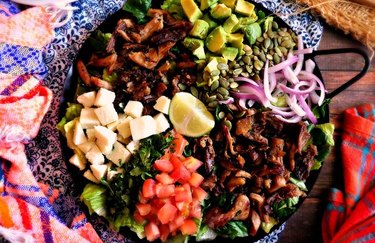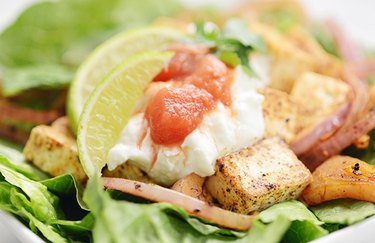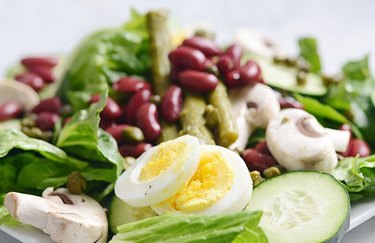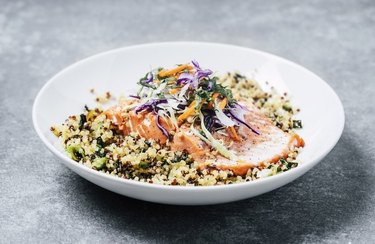
Diet plans and salads go together like movie theaters and popcorn — you don't often find one without the other. And for good reason, with the former: Salads can be beneficial both for meeting your nutritional needs and helping you toward a weight-loss goal.
Here's what you need to know about salad diets, including the best salad recipes to try for your specific diet plan.
Video of the Day
Video of the Day
The Benefits of a Salad Diet for Weight Loss
Adopting a salad-based diet isn't a magic bullet for dropping pounds, but incorporating salads into your eating plan will help you follow the most successful recommendations for weight loss.
Two separate meta-analyses on diet and weight loss, one published September 2017 in Perspectives in Psychological Science and one published January 2018 in Medical Clinics of North America, had the following recommendations regarding food intake:
- Choose high-volume, lower-calorie nutritious foods such as fruits and vegetables
- Eat foods that contain filling protein, and opt for lean protein sources
- Choose lower-fat, higher-protein foods whenever possible
- Prepare meals at home and avoid restaurant-prepared meals and fast food (restaurant salads can contain many hidden calories)
- Measure food and use portion control
- Plan your meals ahead of time
Following a salad diet plan allows you to follow these recommendations daily by incorporating at least one large salad per day.
Read More: How to Eat Salad Every Day to Lose Weight
Can You Lose Weight by Eating Salads?
Salads are a smart addition to just about any eating plan because they typically feature a variety of vegetables, which are high in nutrients and low in calories. Salads can help you lose weight as part of a healthy, balanced, reduced-calorie diet.
How to Adopt a Salad Diet Plan
A salad diet plan doesn't necessarily mean you need to eat salad for breakfast, lunch and dinner, but it should include one really big salad every day. This approach is recommended by many nutrition and exercise professionals alike.
All salads are not created equal, though — making sure your salad choices keep you full without excess calories is key. When following a salad diet for weight loss, build your salad using the following steps.
Step 1: Choose Your Greens
When choosing the base for your salad, go with the greens that satisfy your taste profile. If you like blander greens, opt for a simple chopped romaine or spinach. If you like more variety in flavor, choosing a greens mix that contains arugula, kale and field greens may be a better option.
Step 2: Include Protein
Including protein-packed foods in your salad is a surefire way to making sure your salad is satisfying and maximizes fullness after a meal. A review published June 2015 in the American Journal of Clinical Nutrition found that including 25 to 30 grams of protein per meal led to improvements in weight management and appetite.
When choosing animal-based protein sources, go for leaner options. Chicken breast, lean cuts of pork, shrimp, salmon and hard-boiled egg will provide plenty of protein while minimizing fat intake. For reference, according to the USDA, a 3-ounce serving of cooked lean chicken breast provides 27.3 grams of protein, while a 3-ounce serving of wild Atlantic salmon provides 21.6 grams of protein.
Plant-based sources of protein, like tofu and beans, are also a great option.
Step 3: Add Supporting Veggies
While greens are normally the best choice for the base of your salad, other veggies can play a strong supporting role. Salads should contain veggies from varying categories to increase the nutrition profile of the meal. The easiest way to ensure you're getting a variety is to "eat the rainbow."
What Veggies Go in a Salad?
Any veggies can be used in a salad. With the base being salad greens, adding veggies that are red, purple, orange or yellow will round out your meal. A few options include:
- Red, orange or yellow peppers
- Carrots
- Beets
- Sweet potato
- Tomatoes
If you have a tendency to like your salad a little sweeter, adding fruit is a wonderful option as well.
Step 4: Consider Crunchy Ingredients
Now that you have your salad base of greens, protein and supporting veggies, add some other crunchy ingredients to make the salad fun and satisfying. Regardless of what eating plan you're following, there are plenty of options.
What Can I Add to My Salad?
- Healthy carbs: Corn, roasted and diced sweet potatoes, cooked whole-grain barley, cooked quinoa, diced apples or pears
- Healthy fats: Nuts, seeds, avocado (in moderation)
- Other add-ins: Traditional items like croutons and pita chips are also great options, although these crunchy additions tend to be more calorically dense than other ingredients, so be sure to measure servings sizes first.
Step 5: Use Dressing to Increase Satisfaction and Nutrition
Most people on a salad diet for weight loss assume skipping salad dressing is helpful, but it can reduce your enjoyment of the meal and create a reduction in vitamins and minerals provided by all the nutritious veggies in the salad.
A small study published October 2017 in the American Journal of Clinical Nutrition found those who ate salads with a soybean oil dressing absorbed nutrients better than eating the same salad without dressing. Participants used about 2 tablespoons of dressing, which is the standard serving size for most dressings.
Many store-bought dressings may contain added sugar, so check nutrition labels and measure out serving sizes to keep calories and sugar in check.
How Do You Make a Good Salad?
- Add your salad ingredients into a large bowl to ensure ingredients are evenly distributed
- Toss with 2 tablespoons of your desired dressing
- Scoop the salad into a bowl or plate for a restaurant-style experience
Read more: Can You Lose Weight by Eating Salads and Fruit Only?
Salad Recipes to Try
If you're using a salad diet for weight loss, you may already be following another popular diet plan. Many include lots of veggies, and using salads for meals can be helpful. Here are some salad recipes that fit with each of the following plans.
Keto or Low-Carb Salad
Keeping carbs low on these plans is key to success. This Keto Carnitas Salad is flavorful and delicious while providing only 3 net carbs per serving.
Paleo Salad
This paleo diet focuses on whole, unprocessed foods, which can be time-consuming to make. But this Paleo Charred Lemon Skirt Steak Salad takes only 20 minutes between prep and cook time.
Can You Eat Salad at Night?
While salad may seem like a lunch staple, you can really eat it any time of day to reap the healthy benefits.
Vegan Salad
It can be challenging for some people to meet their protein needs when following a vegan diet, but this Simple Vegan Taco Salad packs 20 grams of protein into each serving.
Mediterranean Salad
When thinking about salads that fit the Mediterranean diet, feta cheese immediately comes to mind. Try this Crunchy Tuna & Feta Salad for a twist on the traditional fare.
Vegetarian Salad
This Simple Vegetarian Chef's Salad uses kidney beans and egg in place of meat. It provides a whopping 25 grams of protein per serving.
DASH Diet Salad
The DASH diet for high blood pressure calls for lots of veggies and whole grains. If you're looking for a break from the traditional base of greens, this Salmon and Broccolette Superfood Salad is worth a try.
Whole30 Salad
This Paleo Citrus-Basil Chicken Salad fits the criteria for Whole30 and provides 32 grams of protein per serving.
Read more: How Whole30 Really Works — and How to Get Started
TLC Diet Salad
Like the DASH diet, the cholesterol-conscious TLC diet focuses on lots of fruits and veggies. This Asparagus and White Bean Dinner Salad provides 21 grams of protein while skipping the meat.
- Perspectives in Psychological Science: "Reducing Calorie Intake May Not Help You Lose Body Weight"
- Medical Clinics of North America:"Maintenance of lost weight and long-term management of obesity"
- American Journal of Clinical Nutrition: "The role of protein in weight loss and maintenance."
- USDA: "Cooked lean chicken breast"
- USDA: "Wild Atlantic Salmon"
- American Journal of Clinical Nutrition:"odeling the dose effects of soybean oil in salad dressing on carotenoid and fat-soluble vitamin bioavailability in salad vegetables."







